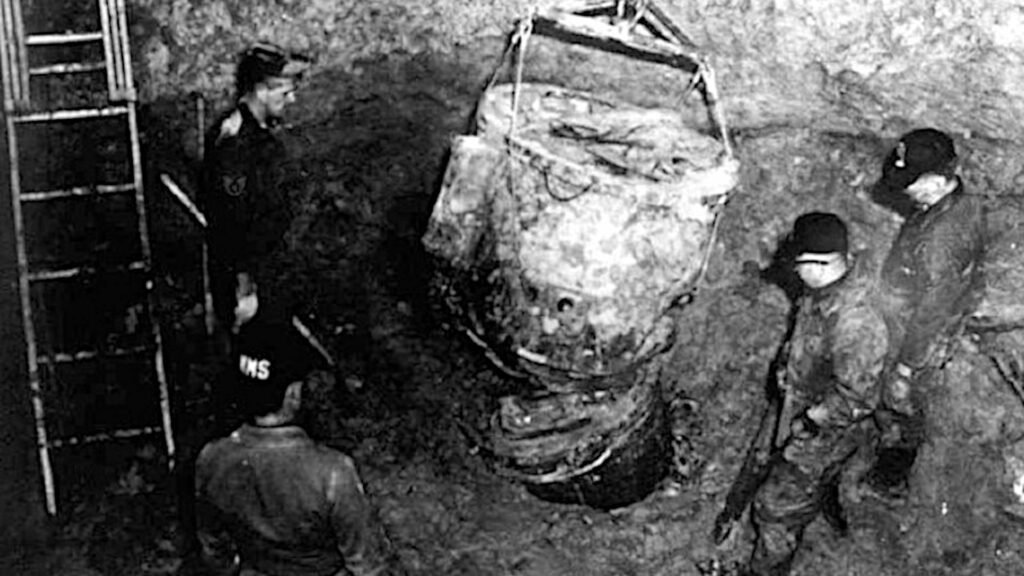The Time North Carolina Was Nearly Nuked
North Carolina 222 is a winding highway, its 58 miles dotted by small towns and rural scenery. It’s a very unassuming stretch of road, perfect for summer drives with the windows down.
Passing through the towns of Belvoir, Fountain, and Saratoga, you’ll find little out of the ordinary for eastern North Carolina; dollar stores and gas stations yield to greenbelts and farmland.
As you enter the Wayne County town of Eureka, you may notice a small sliver of asphalt bearing the name Faro Road. Should you follow this trail for three miles, you’ll find yourself in the small, unincorporated community of Faro.
There’s not much to see, and you wouldn’t think much of note ever goes on here. From the outside, it’s just another piece of land you pass through without a second thought.
But, on a January night in 1961, Faro almost became ground zero of a catastrophe that would have far-reaching implications for the state and the country.
2 Minutes to Midnight
As the 1960s dawned, the United States and the Soviet Union were firmly entrenched in the Cold War. While tensions had not yet reached their peak, the threat of a nuclear exchange was a key concern for both sides.
This spawned another concern—namely being able to either strike first or retaliate should the enemy launch a nuclear attack.
General Thomas S. Power of the U.S. Air Force developed a plan to have nuclear-armed B-52s in the air 24 hours a day. Some of these bombers flew routes that placed them just outside of Soviet airspace, enabling them to strike if ordered.
Others flew domestic routes, patrolling the skies over North America in the event that the U.S.S.R. fired first.
One of these aircraft departed Seymour Johnson Air Force Base in Goldsboro, North Carolina on January 23, 1961. The B-52G, captained by Walter Tulloch, carried a crew of eight along with two Mark 39 thermonuclear bombs.
Each bomb had a yield of 3.8 megatons—over 250 times more powerful than the bomb dropped on Hiroshima during World War II.
Their flight was uneventful, as close to perfect as could be expected given the circumstances. While neither Captain Tulloch nor his crew was aware, something was drastically wrong.
The Accident
As midnight approached, the crew prepared for a mid-air refueling. The crew of the aerial tanker notified Tulloch of a fuel leak originating from the B-52’s right wing.
With the refueling aborted, Tulloch radioed ground control and alerted them to the leak. Instruction came to enter a holding pattern off the coast in order to burn off fuel in preparation for an emergency landing back at Seymour Johnson.
While traveling to their designated location, the crew realized that they had already lost over 37,000 pounds of fuel.
The leak was getting worse.
The crew received orders to return directly to base, a location their plane would never reach.
On approach, the crew found they could no longer maintain a stable rate of descent. Indeed, any manner of control was quickly slipping away. Tulloch ordered the aircraft be abandoned as it passed through 9,000 feet.
Broken Arrow
With no one manning the controls, the B-52 entered an uncontrolled state of descent. As airspeed increased, the damaged airframe began to break up. The rapidly spreading damage reached the bomb bay, freeing the bombs from their hold.
Untethered, they fell from the disintegrating aircraft and fell toward the town of Faro and its citizens.
Both weapons were equipped with parachutes, though only one deployed. The bomb attached to it was found dangling from a tree.
Inspection of this bomb showed that 3 of its 4 arming devices had been triggered during the accident and subsequent fall. The SAFE/ARM switch was the only thing that prevented detonation. It was a close call, closer than I care to think.
However, all was not well.
The parachute on the second bomb failed to deploy, allowing it to gain speed. Ultimately, it slammed into a field, burying itself deep in the soft earth.
An excavation team was able to recover most of the bomb, though a piece of the thermonuclear stage—containing both uranium and plutonium—was unable to be removed.
It’s important to note that the remnants left behind were not capable of creating a nuclear explosion, though they did pose the threat of releasing radiation in the area.
Constant groundwater flooding prevented further excavation of the site. The Army Corps of Engineers purchased an easement on the land directly above the remnants and regularly conducted tests to ensure that radiation wasn’t leeching into the groundwater.
Things Could Have Gone Much Worse
Obviously, neither bomb detonated; if they had, thousands would have died from the blast, tens of thousands would have been injured, and countless others would have fallen ill—many fatally—from radiation sickness, exacerbated by the spread of fallout.
Depending on which direction the wind was blowing, millions would have been affected.
It’s also possible, given the geopolitical climate of the time, that a detonation would have caused confusion regarding the source. Had military leaders believed it to be a Soviet attack, President Kennedy would have faced incredible pressure to retaliate.
Add to this the short window of time to issue such orders, and the structural failure of one aircraft could have triggered an all-out nuclear war.
Aftermath
Sadly, three of the B-52’s crew died during the accident.
Boeing fortified the wings of the B-52 after it was found that the “wet wing” design experienced much higher rates of fatigue than older models.
If you’re interested in a more in-depth read on this topic, check out Joel Dobson’s The Goldsboro Broken Arrow.

